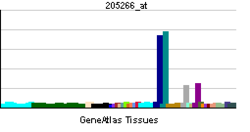Inhibitorni faktor leukemije
| edit |
Inhibitorni faktor leukemije, ili LIF, je citokin iz interleukin 6 klase. Ovaj protein utiče na ćelijski rast i razvoj.
LIF citokin je dobio ime po njegovoj sposobnosti da indukuje terminalnu diferencijaciju ćelija mijeloidne leukemije. Druge osobine ovog citokina su: promocija rasta i ćelijske diferencijacije različitih tipova ciljnih ćelija, uticaj na koštani metabolizam, kaheksiju, neuronski razvoj, embriogenezu i inflamacija. Za p53 regulisani LIF je bilo pokazano da omogućava implantaciju u mišjem modelu.[1][2]
LIF se vezuje za specifični LIF receptor (LIFR-α) koji formira heterodimer sa specifičnom podjedinicom zajedničkom za sve članove te familije receptora, GP130 podjedinicom signalne transdukcije. Ovo dovodi do aktivacije JAK/STAT (Janus kinaza/signal transducer i aktivator transkripcije) i MAPK (mitogenom aktivirana proteinska kinaza) kaskade.
LIF je normalno izražen u trofektodermu embriona u razvoju. Njegov receptor LIFR je izražen širom unutrašnje ćelijske mase. Pošto su embrionske stem ćelije izvedene iz unutrašnje ćelijske mase u stupnju blastocista, njihovo uklanjanje iz unutrašnje ćelijske mase takođe uklanja njihov LIF izvor.
LIF odstranjivanje potiskuje stem ćelije ka diferencijaciji, ali one zadržavaju svoj proliferativni potencijal ili pluripotentnost. Iz tog razloga LIF se koristi u mišjim embrionskim stem ćelijskim kulturama. On je neophodan za održavanje stem ćelija u nediferenciranom stanju. Moguće je genetskim manipulacijom embrionskih stem ćelija omogućiti LIF nezavisni razvoj, posebno prekomernim izražavanjem gena Nanog.
LIF nije neophodan za kulture ljudskih embrionskih stem ćelija.[3][4]
- ↑ Wenwei Hu, Zhaohui Feng, Angelika K. Teresky1, Arnold J. Levine (November 29, 2007). „p53 regulates maternal reproduction through LIF”. Nature 450: 721-724.
- ↑ Mire-Sluis, Anthony R.; Thorpe, Robin, ur. (1998). Cytokines (Handbook of Immunopharmacology). Boston: Academic Press. ISBN 0-12-498340-5.
- ↑ Kawahara Y, Manabe T, Matsumoto M, Kajiume T, Matsumoto M, Yuge L (2009). „LIF-free embryonic stem cell culture in simulated microgravity”. PLoS ONE 4 (7): e6343. DOI:10.1371/journal.pone.0006343. PMC 2710515. PMID 19626124.
- ↑ „CGS : PTO Finds Stem Cell Patent Anticipated, Obvious in Light of 'Significant Guideposts'”.
- Patterson PH (1994). „Leukemia inhibitory factor, a cytokine at the interface between neurobiology and immunology.”. Proc. Natl. Acad. Sci. U.S.A. 91 (17): 7833–5. DOI:10.1073/pnas.91.17.7833. PMC 44497. PMID 8058719.
- Aghajanova L (2005). „Leukemia inhibitory factor and human embryo implantation.”. Ann. N. Y. Acad. Sci. 1034: 176–83. DOI:10.1196/annals.1335.020. PMID 15731310.
- Králícková M, Síma P, Rokyta Z (2005). „Role of the leukemia-inhibitory factor gene mutations in infertile women: the embryo-endometrial cytokine cross talk during implantation--a delicate homeostatic equilibrium.”. Folia Microbiol. (Praha) 50 (3): 179–86. DOI:10.1007/BF02931563. PMID 16295654.
- Stahl J, Gearing DP, Willson TA, et al. (1990). „Structural organization of the genes for murine and human leukemia inhibitory factor. Evolutionary conservation of coding and non-coding regions.”. J. Biol. Chem. 265 (15): 8833–41. PMID 1692837.
- Bazan JF (1991). „Neuropoietic cytokines in the hematopoietic fold.”. Neuron 7 (2): 197–208. DOI:10.1016/0896-6273(91)90258-2. PMID 1714745.
- Lowe DG, Nunes W, Bombara M, et al. (1989). „Genomic cloning and heterologous expression of human differentiation-stimulating factor.”. DNA 8 (5): 351–9. PMID 2475312.
- Sutherland GR, Baker E, Hyland VJ, et al. (1989). „The gene for human leukemia inhibitory factor (LIF) maps to 22q12.”. Leukemia 3 (1): 9–13. PMID 2491897.
- Mori M, Yamaguchi K, Abe K (1989). „Purification of a lipoprotein lipase-inhibiting protein produced by a melanoma cell line associated with cancer cachexia.”. Biochem. Biophys. Res. Commun. 160 (3): 1085–92. DOI:10.1016/S0006-291X(89)80114-7. PMID 2730639.
- Gough NM, Gearing DP, King JA, et al. (1988). „Molecular cloning and expression of the human homologue of the murine gene encoding myeloid leukemia-inhibitory factor.”. Proc. Natl. Acad. Sci. U.S.A. 85 (8): 2623–7. DOI:10.1073/pnas.85.8.2623. PMC 280050. PMID 3128791.
- Williams RL, Hilton DJ, Pease S, et al. (1989). „Myeloid leukaemia inhibitory factor maintains the developmental potential of embryonic stem cells.”. Nature 336 (6200): 684–7. DOI:10.1038/336684a0. PMID 3143916.
- Moreau JF, Donaldson DD, Bennett F, et al. (1989). „Leukaemia inhibitory factor is identical to the myeloid growth factor human interleukin for DA cells.”. Nature 336 (6200): 690–2. DOI:10.1038/336690a0. PMID 3143918.
- Yamaguchi M, Miki N, Ono M, et al. (1995). „Inhibition of growth hormone-releasing factor production in mouse placenta by cytokines using gp130 as a signal transducer.”. Endocrinology 136 (3): 1072–8. DOI:10.1210/en.136.3.1072. PMID 7867561.
- Schmelzer CH, Harris RJ, Butler D, et al. (1993). „Glycosylation pattern and disulfide assignments of recombinant human differentiation-stimulating factor.”. Arch. Biochem. Biophys. 302 (2): 484–9. DOI:10.1006/abbi.1993.1243. PMID 8489250.
- Aikawa J, Ikeda-Naiki S, Ohgane J, et al. (1997). „Molecular cloning of rat leukemia inhibitory factor receptor alpha-chain gene and its expression during pregnancy.”. Biochim. Biophys. Acta 1353 (3): 266–76. PMID 9349722.
- Hinds MG, Maurer T, Zhang JG, et al. (1998). „Solution structure of leukemia inhibitory factor.”. J. Biol. Chem. 273 (22): 13738–45. DOI:10.1074/jbc.273.22.13738. PMID 9593715.
- „Toward a complete human genome sequence.”. Genome Res. 8 (11): 1097–108. 1999. PMID 9847074.
- Tanaka M, Hara T, Copeland NG, et al. (1999). „Reconstitution of the functional mouse oncostatin M (OSM) receptor: molecular cloning of the mouse OSM receptor beta subunit.”. Blood 93 (3): 804–15. PMID 9920829.
- Nakashima K, Yanagisawa M, Arakawa H, et al. (1999). „Synergistic signaling in fetal brain by STAT3-Smad1 complex bridged by p300.”. Science 284 (5413): 479–82. DOI:10.1126/science.284.5413.479. PMID 10205054.
- Dunham I, Shimizu N, Roe BA, et al. (1999). „The DNA sequence of human chromosome 22.”. Nature 402 (6761): 489–95. DOI:10.1038/990031. PMID 10591208.



